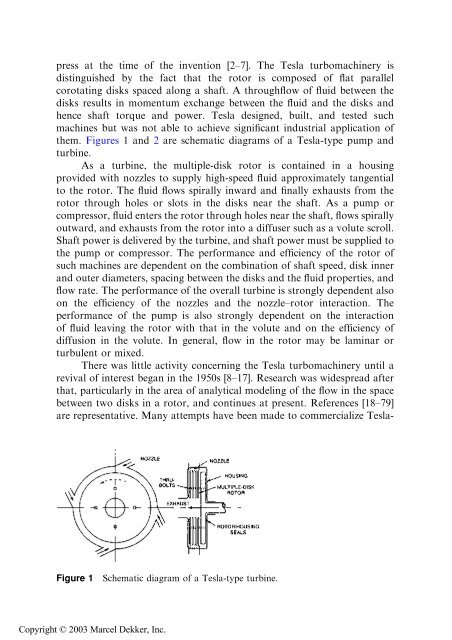Handbook of Turbomachinery, Second Edition
Handbook of Turbomachinery, Second Edition
Handbook of Turbomachinery, Second Edition
You also want an ePaper? Increase the reach of your titles
YUMPU automatically turns print PDFs into web optimized ePapers that Google loves.
press at the time <strong>of</strong> the invention [2–7]. The Tesla turbomachinery is<br />
distinguished by the fact that the rotor is composed <strong>of</strong> flat parallel<br />
corotating disks spaced along a shaft. A throughflow <strong>of</strong> fluid between the<br />
disks results in momentum exchange between the fluid and the disks and<br />
hence shaft torque and power. Tesla designed, built, and tested such<br />
machines but was not able to achieve significant industrial application <strong>of</strong><br />
them. Figures 1and 2are schematic diagrams <strong>of</strong> aTesla-type pump and<br />
turbine.<br />
As a turbine, the multiple-disk rotor is contained in a housing<br />
provided with nozzles to supply high-speed fluid approximately tangential<br />
to the rotor. The fluid flows spirally inward and finally exhausts from the<br />
rotor through holes or slots in the disks near the shaft. As a pump or<br />
compressor, fluid enters the rotor through holes near the shaft, flows spirally<br />
outward, and exhausts from the rotor into a diffuser such as a volute scroll.<br />
Shaft power is delivered by the turbine, and shaft power must be supplied to<br />
the pump or compressor. The performance and efficiency <strong>of</strong> the rotor <strong>of</strong><br />
such machines are dependent on the combination <strong>of</strong> shaft speed, disk inner<br />
and outer diameters, spacing between the disks and the fluid properties, and<br />
flow rate. The performance <strong>of</strong> the overall turbine is strongly dependent also<br />
on the efficiency <strong>of</strong> the nozzles and the nozzle–rotor interaction. The<br />
performance <strong>of</strong> the pump is also strongly dependent on the interaction<br />
<strong>of</strong> fluid leaving the rotor with that in the volute and on the efficiency <strong>of</strong><br />
diffusion in the volute. In general, flow in the rotor may be laminar or<br />
turbulent or mixed.<br />
There was little activity concerning the Tesla turbomachinery until a<br />
revival <strong>of</strong> interest began in the 1950s [8–17]. Research was widespread after<br />
that, particularly in the area <strong>of</strong> analytical modeling <strong>of</strong> the flow in the space<br />
between two disks in a rotor, and continues at present. References [18–79]<br />
are representative. Many attempts have been made to commercialize Tesla-<br />
Figure 1 Schematic diagram <strong>of</strong> a Tesla-type turbine.<br />
Copyright © 2003 Marcel Dekker, Inc.
















